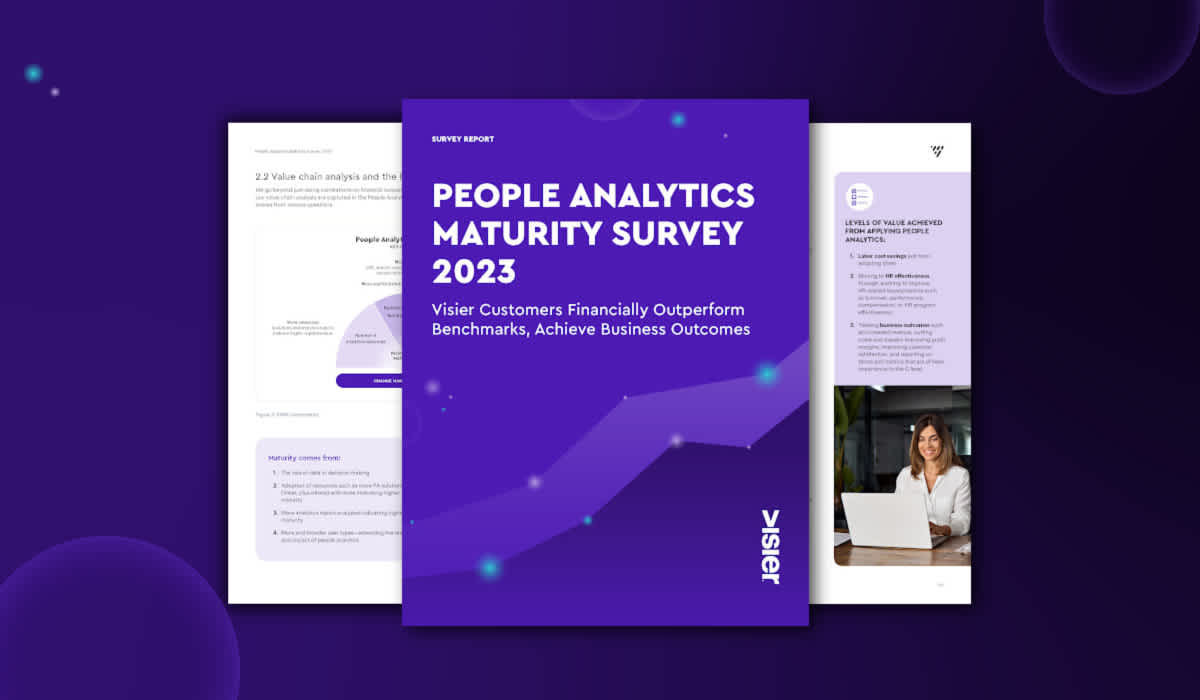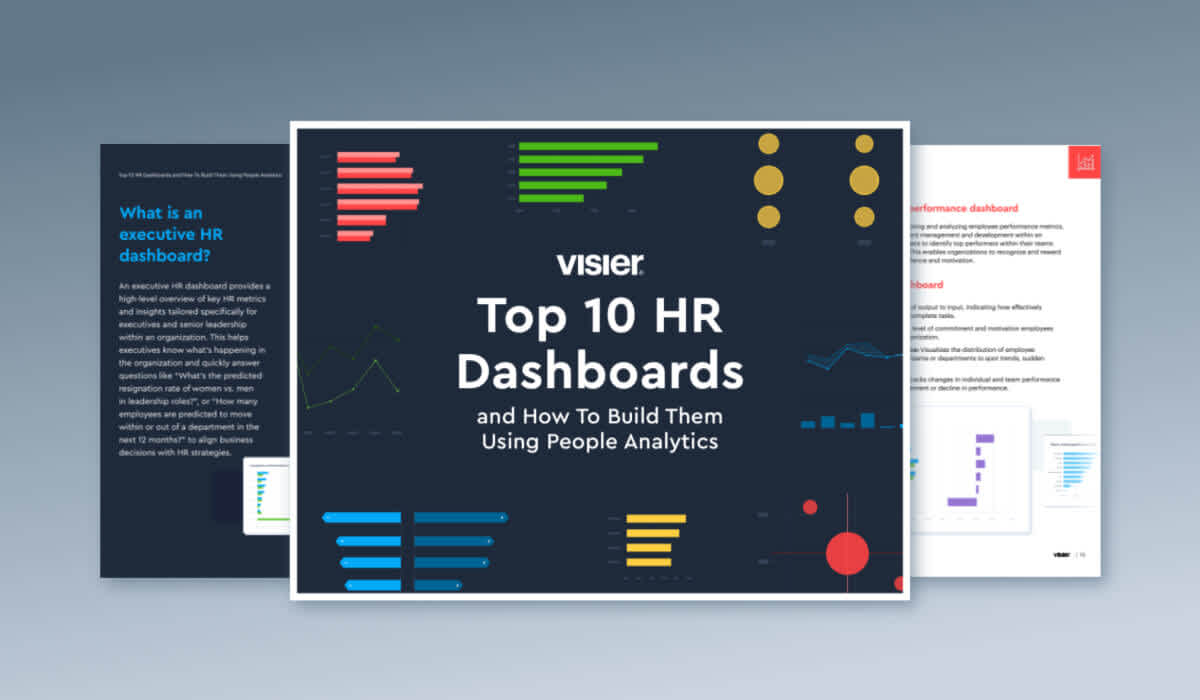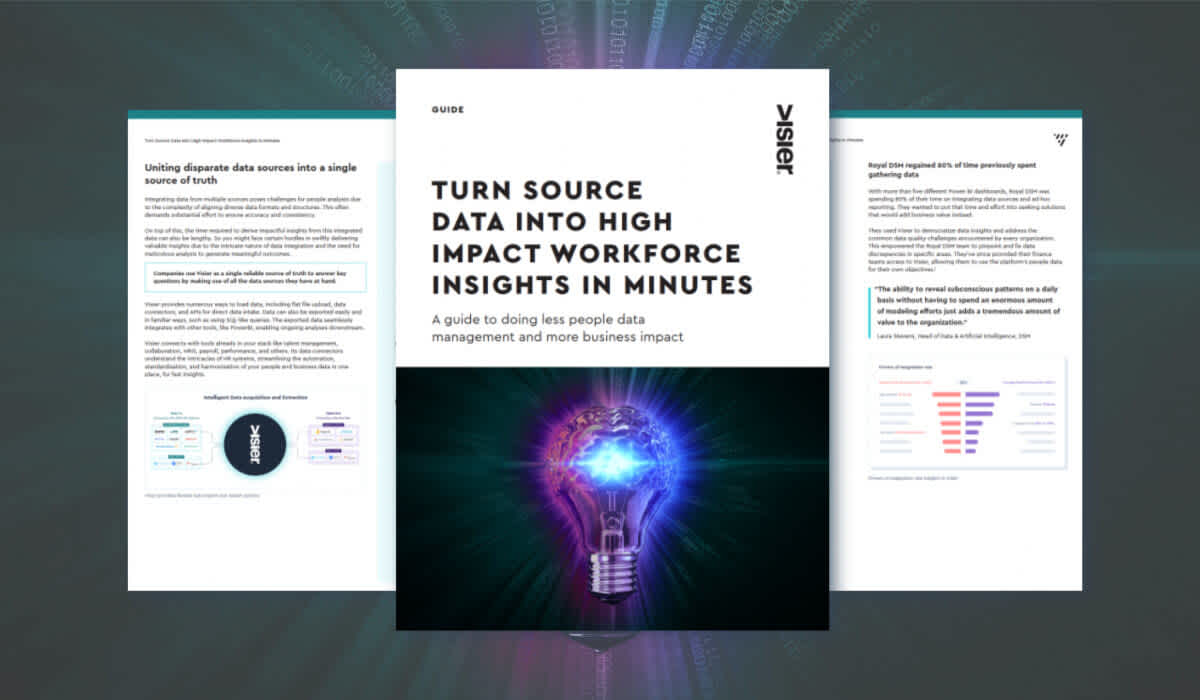What Is People Analytics and How Do I Get Started?
What is people analytics? Learn the basics of people analytics–also known as HR analytics or workforce analytics–in this introductory article.

Organizations use people analytics to turn raw data into meaningful insights that improve the ways they make decisions and grow the business. People analytics tools pull data from many business sources into one place and show the data as intuitive charts, graphs, and questions. People analytics is now a must-have for every organization. Let’s take a deeper dive:
What is people analytics?
People analytics is the practice of collecting and transforming HR data and organizational data into actionable insights that improve the way you do business. You'll also see people analytics called HR analytics or workforce analytics—they’re the same thing.
The term “analytics” is often used interchangeably with other terms like “reports” and “business intelligence,” but these aren't the same thing.
A Deloitte and Visier survey of 500 business leaders revealed leaders had low confidence in addressing some of their most pervasive, everyday business and people topics. However, with better access to people data, 70% of executives say they could make better decisions, faster.

Why is people analytics important?
People are the center of the business. Employees create products, deliver services, delight customers, and solve complex problems. People analytics gives you the information you need to make data driven decisions that impact your organization’s most important areas: your people and the bottom line.
People analytics teams help HR, business, and people leaders make data driven decisions to maximize employee potential and business results. But, you don't have to be a people analyst to use people analytics. The most successful organizations put these insights in the hands of every leader in the company.
Organizations that use people analytics well outperform those that don’t. Visier customers have a higher return on assets, profit margins, and return on equity than industry benchmarks.
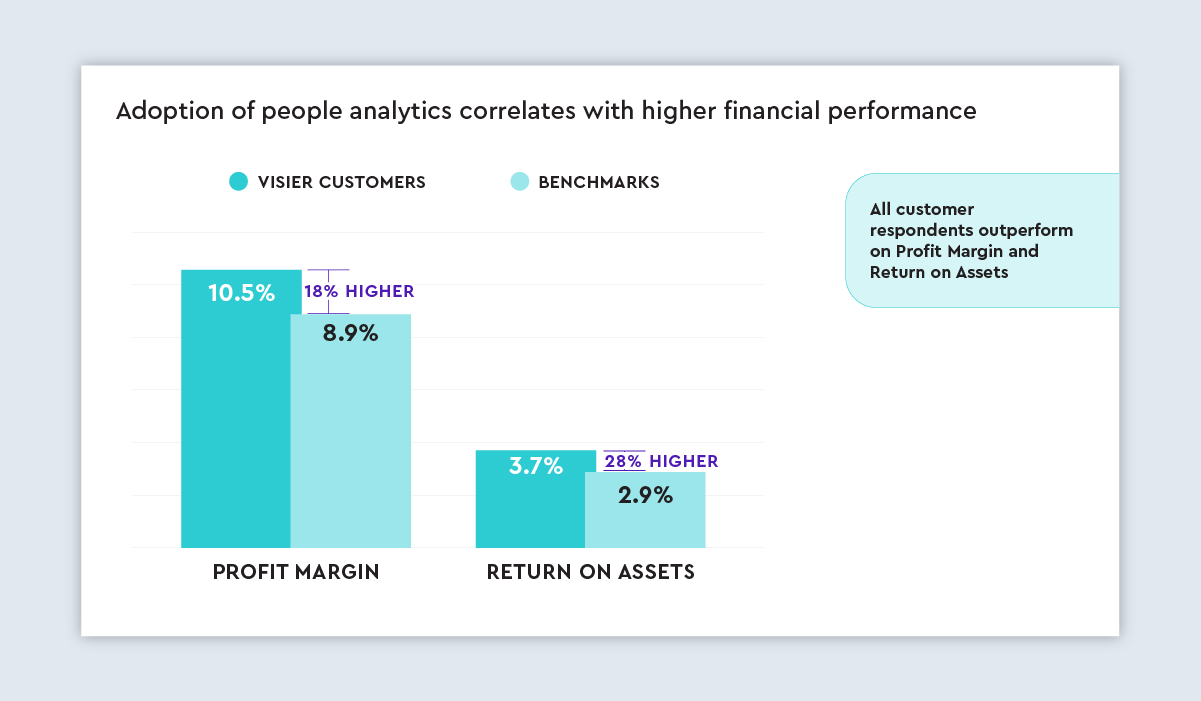
The People Analytics Maturity Value Report revealed experienced practitioners of people analytics gained business advantages.
Real outcomes of businesses using people analytics
Providence saved millions of dollars in turnover through targeted pay increases
Sunstate Equipment used insights to reduce turnover by 50%
Royal DSM regained 80% of time previously spent gathering data
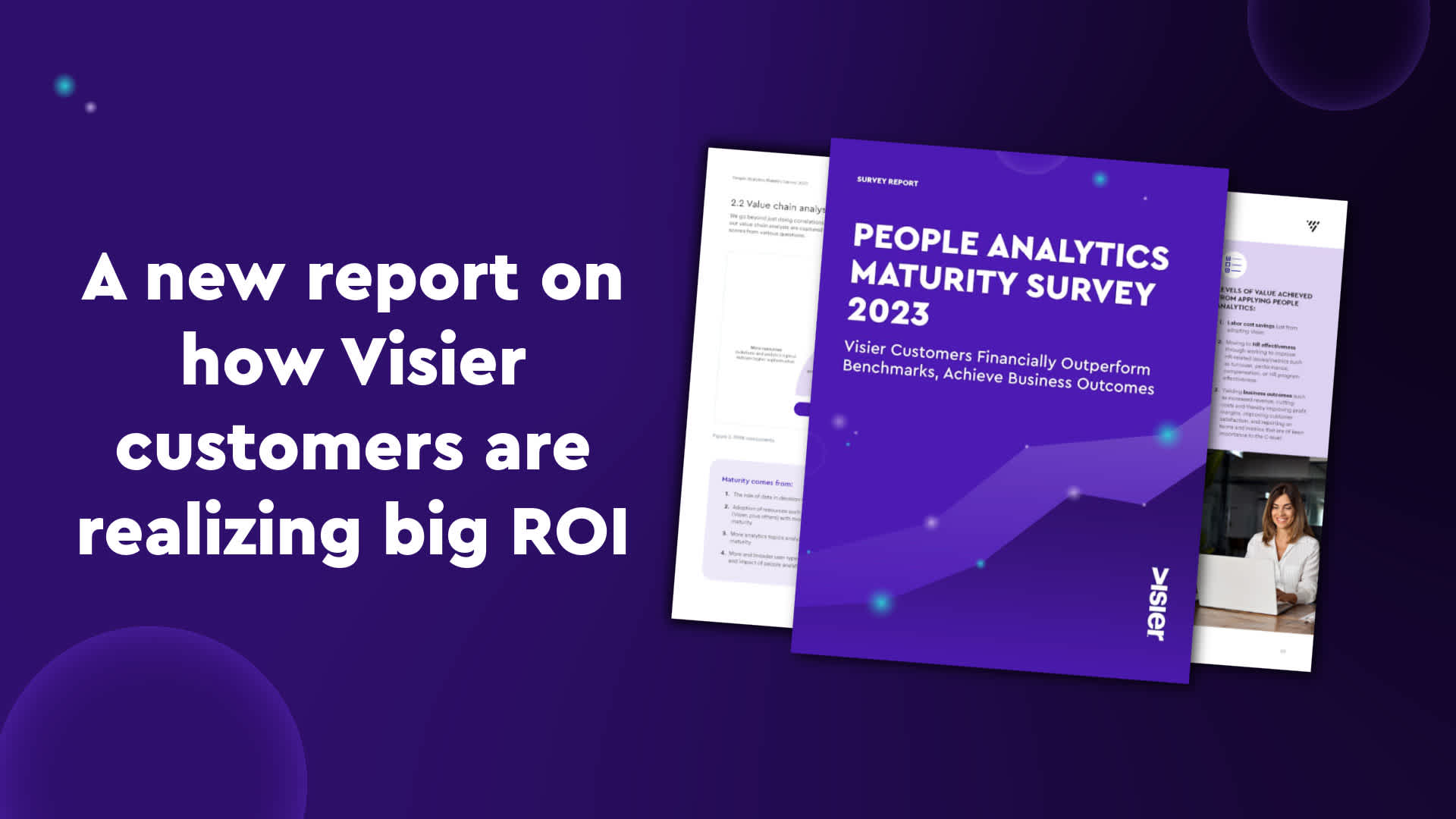
How does people analytics work?
People analytics pulls raw data from the digital HR tools your organization is already using and applies algorithms, calculations, and machine learning to create charts and graphs that every leader can use to make talent decisions. The most robust people analytics platforms act as a hub for disparate people and business data.
What's the difference between analytics and transactional reports? The ability to use and process new and historical data, apply AI to it, and produce actionable insights. Reports can show basic HR metrics but can’t provide insight into why a problem is happening and how to fix it. The takeaway: Analytics provides actionable insight, while reports simply provide data.
The three main components of people analytics are data, analytics, and insights.
1. People data
What’s people data? It’s all the information an organization collects about its employees: data points like age, tenure, gender, job role, salary, quits, performance ratings, and more job-specific data like sales quotas or closed support tickets, for instance.
People analytics software pulls this information via API from your digital HR tools (HRIS, HCM, ATS, payroll, etc.), applicant tracking, onboarding, compensation, talent management, and payroll systems and transforms it using data science.
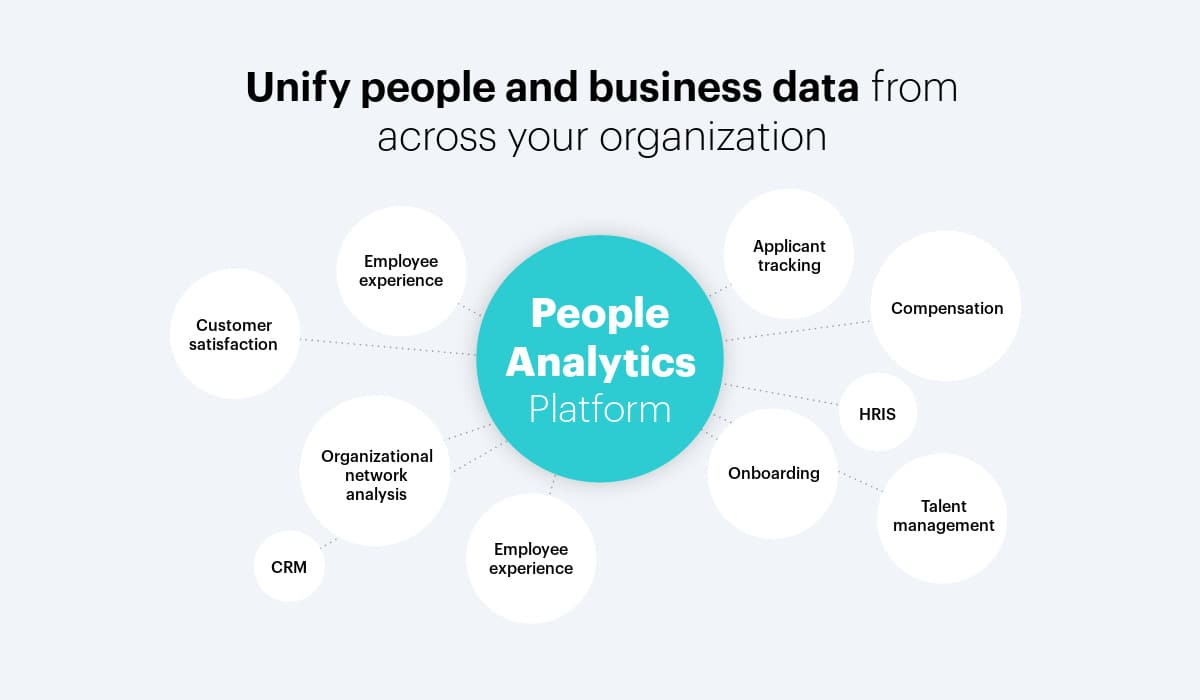
People analytics software pulls data from all of your digital HR and business systems into one unified view.
2. Analytics
Your people analytics platform operates like your own in-house HR data analyst. The data is processed, cleaned, and organized so the platform can apply complex equations, algorithms, machine learning, and analytics. This is how your raw data becomes something much more digestible: insights.
Building an analytic data model is also a critical step in this process. The data model creates relationships between different data points, making the data more useful to businesses. Without this capability, leaders can’t ask multidimensional questions like:
How should we reorient our production operations to ensure we have enough people to meet our targets?
What impact will resignations and wage inflation have on our operating costs?
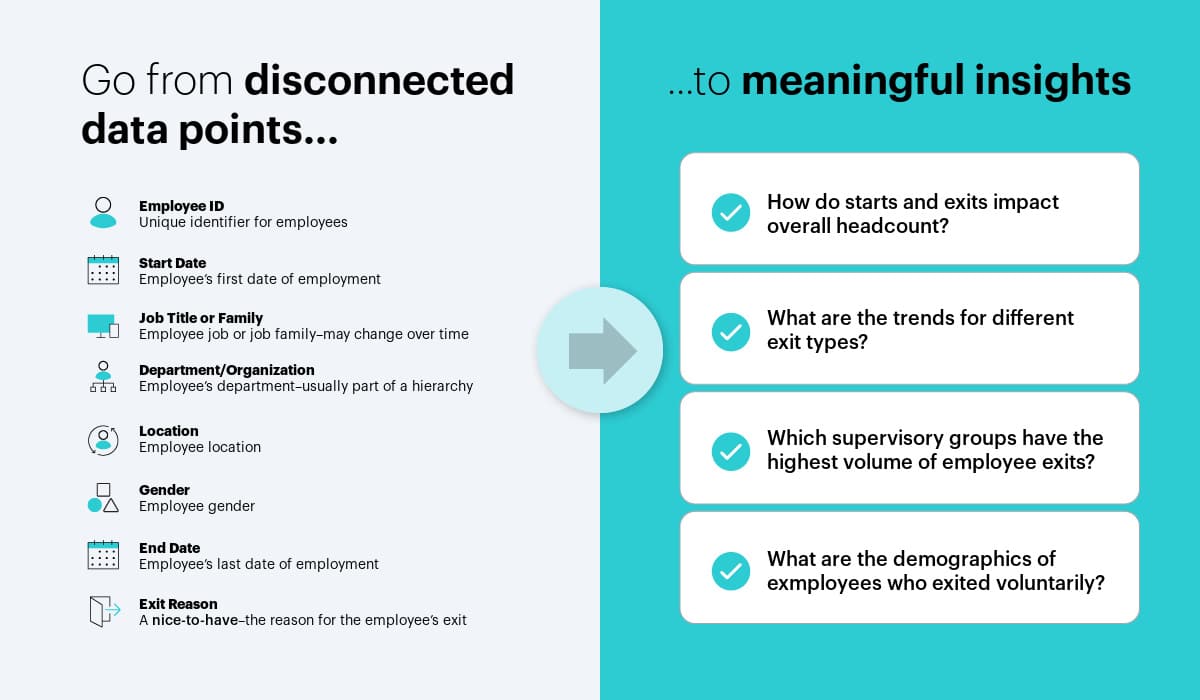
People analytics takes disparate datapoints about employees and turns them into useful insights that can positively impact the business.
3. Insights
Your people analytics platform presents insights in a consumable way. Rather than looking at raw numbers, you’ll see charts, graphs, questions, answers, and guidebooks that are easy to understand and act on.
In the past, HR professionals and business leaders needed the IT department to start a business intelligence project when they wanted to perform data analysis. With people analytics platforms, users have access to simplified views so they can analyze data on their own—and much quicker, too.

Use a people analytics platforms to answer questions such as, "Who is at high risk of resignation because they are similar to this employee?"

How do you use people analytics to make decisions?
So, what exactly can you do with people analytics? Every day, decisions are being made across your organization that impact your people. With people analytics, leaders have access to the insights they need to back up their instincts with facts and data-driven strategies that help their organization grow.
People analytics shows your data in one view so you can answer and act on important questions, and answer questions you haven't thought of to avoid unintentional biases that contribute to bad business decisions. Here are some examples of questions people analytics can help answer:
Does the organization need to hire more people?
Who needs a promotion?
Who might be at risk of quitting?
Protective Life Corporation, an insurance company, rolled out people analytics to users throughout their organization. HR was able to provide more facts and data, which evolved the perception of what the department can do, and what it’s capable of. Their goal was to foster participation among frontline and mid-level managers—the ones with the power to enact real change.
6 ways to apply people analytics to your business
People analytics enables business leaders and people managers to make better-informed people decisions during hiring, compensation reviews, internal movement, and promotions. It can also mitigate risks and ensure compliance when coupled with learning and development options.
Common recruiting metrics, such as “time-to-fill” and “offers accepted rate,” don't answer strategic questions about the quality and value of the people being hired. A true analytics tool goes further, enabling you to change and improve many aspects of your business, such as:
Improve talent acquisition: Identify what candidate attributes produce quality talent to hire smarter.
Tackle turnover problems: Identify employees and specific groups at risk of leaving and take action before they walk out the door.
Meet DEIB goals: Track the metrics that matter to you, such as diversity ratios at every single stage in the hiring funnel, so you can share your progress and get ahead of areas of risk.
Measure performance rewards: Track movement within the company and correlate it with total rewards, compa-ratio, and performance levels to determine if you are effectively rewarding performance.
Plan career paths for success: Analyze career paths to develop existing employees to meet future needs and consider your total cost of workforce to accurately plan for the future.
Maximize your learning investment: Analyze how long employees take to become productive, which training programs are best, and which need improvement.
How to get started with people analytics in 3 steps
1. Determine if your organization is truly ready
A people analytics solution has significant impact on organizational success, but a tool is only as impactful as the people using it. If your organization isn’t fully prepared to make changes in how things are done, you might not be ready to invest in an analytics platform quite yet.
People analytics, and the workforce planning advantages that come with it, is less about tools, technology, statistics, artificial intelligence, and complicated data science than we think. When it comes to the practical application of analytics, it is far more about change management.
2. Find your data champions
Convincing your company’s leadership team to undertake a people analytics project isn’t always easy. Building a data-driven culture requires a full organizational shift and change management plan.
Fellow internal data champions can help you build your business case, and navigate the organizational change required to fully put people analytics to use.
Do people managers need to become statisticians to use people analytics?
The right people analytics platform makes it possible for everyone to adopt a more analytic approach to people data. When you put insights in the hands of leaders at every level, they can take swift actions to make better decisions that improve talent and business results.
Data scientists and analysts are still invaluable for more advanced analytics work. With a people analytics solution that has pre-built best practices, your data scientists and analysts are freed up to focus on advanced problems and models for unique circumstances.
3. Define your questions
People analytics relies on strategic, relevant questions. While you’ll still be able to draw insight into your organization without clearly defined questions, you won’t see the same level of impact and organizational change.
Define how HR and your workforce fits into your big picture goals, then work back to the types of questions you’d like to answer to move the needle on that goal. Once you’ve identified your key questions, it’s time to select the right people analytics solution for your company.
People analytics enables you to go beyond typical HR questions to understand the “why”:
Why are you overspending on your overtime budget?
Did you lose a key employee or department, and the overtime is to compensate for this?
Why are your total rewards not aligned with the actual needs and wants of your employees?

How much HR data do you need to get started with people analytics?
To get started with people analytics, you need to collect at least seven data points for each employee who will be included in the analyses:
A unique employee ID
Start date
Job title
Department name
Location
Identifiers for DEI purposes
End date (if applicable)
These foundational HR data points will help answer basic questions related to critical issues such as employee turnover and the representation of people from certain backgrounds in key roles. You can use HR and business data from your core HR systems like your payroll and recruiting tools, data from your talent and employee experience systems like your career pathing and engagement applications, and any relevant business operations and finance data.
The more data your organization puts in, the greater the insights and return on investment you'll get in return. According to Visier’s People Analytics Maturity Survey 2023 report, higher people analytics maturity leads to improved business outcomes. A key component of higher people analytics maturity is leveraging more data sources.
Employee experience data is becoming increasingly critical to people analytics. 70% of HR and business professionals agree “that business leaders have shown more interest in employee experience since the start of the COVID-19 pandemic,” according to a survey conducted by Insight222. In short, there is a growing recognition that the employee experience is becoming just as important as the customer experience, and the data needs to reflect this shift.
People analytics helps businesses reveal the human truth
It can be argued that understanding your employees is as important—if not more—than understanding the customer these days. Organizations that view their people as equal partners in value creation will thrive in this new era of the people-powered enterprise. People analytics is the key to understanding the explicit connection between people and business goals, revealing the fundamental questions and actionable truths to elevate your employees—and your business—to new heights.
People analytics FAQs
What is people analytics?
People analytics is the collection and transformation of HR data and organizational data into actionable insights that improve critical talent and business outcomes.
Are people analytics and HR analytics the same thing?
Yes, the terms people analytics and HR analytics refer to the same practice of gathering and transforming people data and HR data into actionable insights for to improve critical talent outcomes like improving manager effectiveness, measuring performance rewards, and improving employee turnover, as well as financial outcomes and overall business success.
What is the role of people analytics?
People analytics help HR, business, and people leaders make data-driven decisions to maximize employee potential, reduce bias, and improve business results.
Looking for more information on getting started with people analytics? Read more:
People Analytics 101: How to Meet Business Goals with People Data
3 Ways to Succeed with People Analytics, According to New Survey
On the Outsmart blog, we write about workforce-related topics like what makes a good manager, how to reduce employee turnover, and reskilling employees. We also report on trending topics like artificial intelligence, using generative AI in HR, and how skills are rapidly evolving, and advise on HR best practices like how to create a strategic compensation strategy, how to manage HR data, and how to use reports vs. analytics. But if you really want to know the bread and butter of Visier, read our post about the benefits of people analytics.

Get the Outsmart newsletter
You can unsubscribe at any time. For more information, check out Visier's Privacy Statement.
